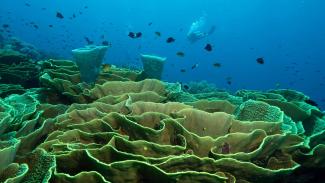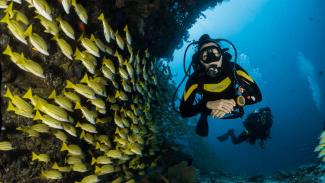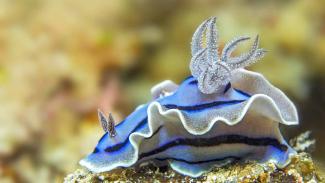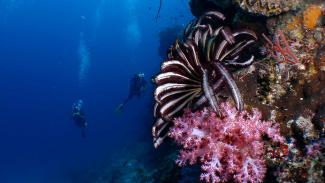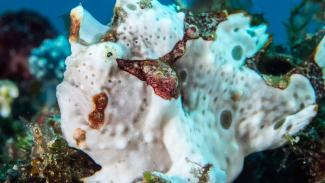Your guide to Myanmar's best diving
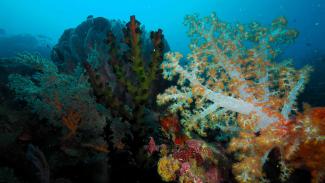
The 800 islands that comprise the Mergui Archipelago lie just off the coast of Myanmar in the Andaman Sea.
The islands, which can only be reached from Thailand, are only a fairly recent addition to liveaboard diving itineraries, and have not yet been completely explored. Those areas that are now well known to dive operators offer some exceptional diving.
The more exposed sites normally enjoy excellent visibility and plenty of pelagic encounters, while sites closer to land hide numerous smaller delights for macro-lovers.
Highlights
Best diving spots
The islands, which can only be reached from Thailand, are only a fairly recent addition to liveaboard itineraries, and have not yet been completely explored. Those areas that are now well known to dive operators offer some exceptional diving. Almost as soon as you enter Burmese waters, you come to a site known as Western Rocky Island. This small island, almost directly north of Thailand’s Surin Islands, has a tunnel stretching from one side of the island to the other. The tunnel, which is about 30m in length and 20-25m deep, is home to large Nurse Sharks and can be dived by experienced divers. There is great wall diving here and areas where larger pelagics can be seen, including numerous shark species.
Further into Burmese Waters, North & South Twin are two very popular sites. Boulders covered in beautiful soft corals create numerous canyons & overhangs. Ribbon Eels can be found here and Spanish Dancers are sometimes seen, especially at night. In the blue, there is a chance to encounter Eagle Rays & Mantas. Leopard Sharks & Nurse Sharks are seen here & Bull Sharks have been encountered too.
A little to the east is Three Islets. Here, a large cave hides Nurse Sharks & occasional Grey Reef Sharks. The north-east side of the site is a great place to look for smaller life, such as Ghost Pipefish & Seahorses. Fantail Rays can be seen here too & reef-life is prolific.
Further north again, Black Rock and Tower Rock are most definately big fish dives. Manta Rays are commonly seen at these sites, and their smaller cousins, the Mobula or Devil Ray often cruise by in large schools. Eagle Rays also pop in to pay a visit and schools of Fantail Rays occasionally fly by to join the show. Sharks are seen here too, including Leopard Sharks, Silvertips & even Bull Sharks. West Canister, at the northern end of the archipelago, is another great spot for Manta Rays.
Megui isn’t all about the big fish however. At sites such as Little Torres, Freak Island & High Rock, plenty of smaller life can be found. Frogfish, Stonefish, Ghost Pipefish, Sponge Crabs, Harelquin Shrimps & Seahorses are all there to be found by the eagle-eyed diver.
When to dive
The weather in Burma, like the Andaman coast of Thailand to the south, is influenced by the Indian monsoon. The best conditions are from December through to April, with wetter weather possible outside of these months.
Getting there
The majority of people looking to dive Burma go through Thailand, arriving to Phuket's international airport. From there, most take a liveaboard departing from Thailand over the border. There are some limited resorts that require travel by land over the border.
Activities
If joining a liveaboard, diving is naturally the main focus. Resort based options in Burma's Mergui archipelago offer options for nature, trekking and simply relaxing.
Resort and liveaboard options
The majority of divers visiting Myanmar do so on a liveaboard departing Thailand to the south and crossing into Burmese waters. Liveaboards generally operate out of Tap Lamu, to the south of Khao Lak.
There are also a few eco and nature resorts offering diving in the archipelago.
It is recommended to ensure you are familiar with the entry requirements before making the journey to Myanmar.

How to dive Myanmar
Myanmar can be dived from liveaboard, with liveaboard vessels departing from the Andaman (west) coast of Thailand and heading north into Myanmar. Departures are usually offered between January and March each year. Itineraries are available to book on the Smiling Seahorse and the Phinisi through liveaboard.com
Myanmar Snapshot
- When to go: November through to April, however liveaboard departures often January to March only.
- Marine life highlights: Blacktip Shark, Silvertip Shark, Manta Ray
- How to reach: Join a liveaboard from Chalong (Phuket), Khao Lak or Ranong in Thailand.
- Prices guide: Myanmar liveaboards begin from around USD115 per day. Bear in mind there are entry fees to pay of USD250 per person.
You might also enjoy...
Kimbe Bay
Kimbe Bay is on the island of New Britain, a large island running east to west that separates the Solomon Sea to the south from the Bismark Sea to the north.
The area is known for its stunning coral formations and boasts a huge diversity of marine life, from Dolphins, Sharks and Whales to endless tiny invertebrates.
Ambon & the Banda Sea
The Banda Sea is a deep sea ringed by islands in eastern Indonesia. Right in the middle of the sea are the Banda Islands, while Ambon lies to the north.
While they may seem incredibly remote, they were once world famous as the Spice Islands, where nutmeg & mace - much sought after in those days - were grown & fought over by colonial powers.
Alor
Alor lies to the east of Flores & north of Timor Island. Divers who venture this far will be rewarded with exceptional diving away from the crowds.
The area is characterised by two main forms of diving - current swept dives with a high chance to find pelagics; and world-class muck diving.
Scuba diving in Borneo - 7 key questions answered
Tara North


